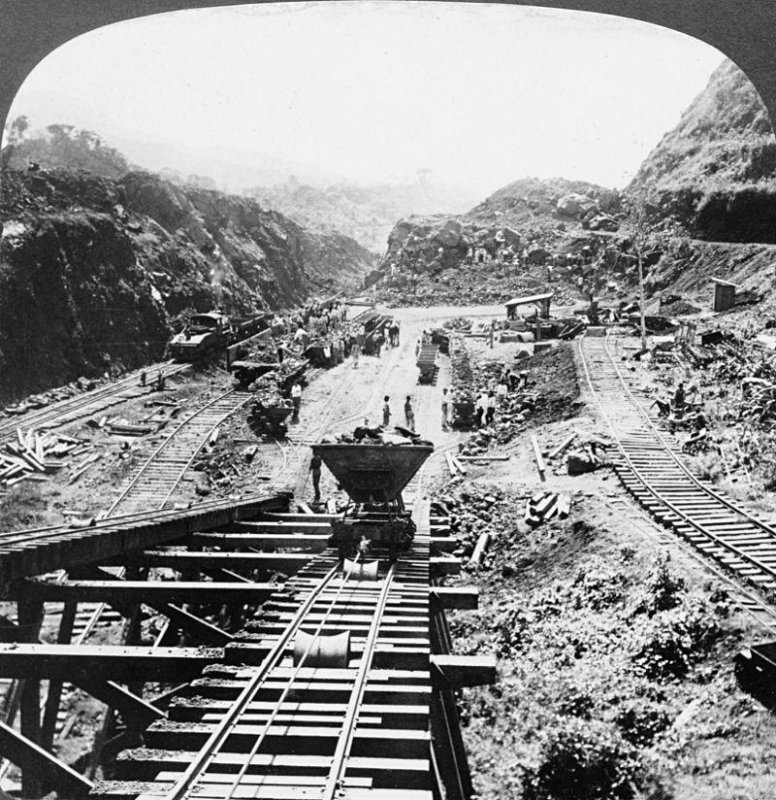1 of 3 | The Panama Canal under construction in 1907 (Library of Congress).
PANAMA CITY, Panama, Aug. 15 (UPI) -- The Panama Canal opened for business 100 years ago Friday and has seen nearly a million ships pass through it.
The centennial celebration honoring the passage of the cargo ship S.S. Ancon through the Panama Canal's arrangement of locks and man-made lakes on August 15, 1914, will feature a concert, fireworks and a 500-pound cake shaped like a canal lock. However, the festivities will be significantly subdued.
The canal's $5.25 billion expansion, which began with approval of a 2006 referendum and was supposed to be completed in time for the anniversary, has been delayed and extended to December 2015. The expansion, along with the canal's relevance to 21st-century shipping, remains a cause of worry.
While the 100-year-old locks still work, the canal's transit fees handsomely augment Panama's economy. Meanwhile, history regards the Panama Canal as a triumph of engineering and organization -- the moon shot of its era.
Theoretically, it is simple. Carve a channel between the Atlantic and Pacific Oceans at the narrowest point of the Western Hemisphere, the Isthmus of Panama, thereby rendering dangerous and time-consuming maritime travel around South America unnecessary. It takes only 20 to 30 hours to pass through the east-west (actually, northeast-southeast) Panama Canal.
The first exploratory survey for a canal came in 1534, ordered by Charles V, King of Spain and the Holy Roman Empire, who sought a quicker route between Spain and Peru. A railway across the isthmus was opened in 1855 to capitalize on the California gold rush, the same year a U.S. survey for a canal was completed.
It was left to the French, having constructed the Suez Canal in 1869, to attempt building a sea-level canal, without locks, across what was then part of Colombia. With inadequate geological research, primitive steam-powered equipment and the deaths of an estimated 22,000 workers to accidents and malaria -- the connection between malaria and disease-bearing mosquitoes was not established at the time -- they failed spectacularly after losing $287 million. A second attempt by a French corporation, in 1894, lost $109 million before the project was abandoned.
The United States undertook the still-valid project in 1903, as Panamanian rebels sought independence from Colombia with U.S. support. In the space of a week in November 1903, U.S. warships blockaded sea lanes to prevent Colombian troops from entering Panama, the new nation declared independence and received U.S. recognition; in return, the right to build and administer the Panama Canal was granted to the United States.
It was referred to as "gunboat diplomacy," not the last time the United States dealt with Latin American nations in that manner. Panama and Colombia were compensated for the upheaval.
U.S. efforts quickly became legendary and came at a cost of $375 million. President Theodore Roosevelt boldly took the reins of a previously impossible project, as Presidents William Howard Taft and Woodrow Wilson oversaw its completion. Excavators moved 170 million cubic yards of rocks and earth -- over five times the amount the French moved in their attempt -- as American-made heavy machinery replaced the rusting French models. Meanwhile, the U.S. led a sanitation campaign to rid Panama of mosquitoes and malaria. About 5,600 workers died of accidents and illnesses in the American phase of construction.
As constructed, the 48-mile-long canal includes six locks to lift and lower ships, and the largest man-made lake built at that time. A dam was added in 1935, and constant improvements have led to the current construction project, to accommodate ever-larger cargo ships.
Panama has been praised for efficiently overseeing the canal since it gained custody from the United States in 2000. The canal has been widened and modernized, and ships passing through and paying tolls according to tonnage of freight, or number of berths in the case of passenger cruise ships, add $1 billion annually to Panama's economy. Each ship averages a $54,000 toll; the largest was $375,600 in 2010 for the cruise ship Norwegian Pearl, the lowest a fee of 36 cents, charged in 1928 to Richard Halliburton, who swam the canal.
Although a centenary is usually an opportunity to celebrate history, the future of the Panama Canal remains in doubt, exemplified by the delay in the expansion project. Disputes with labor unions, and between the European consortium and the administrators of the canal, have pushed the deadline back.
There is also competition. Last month, a Chinese firm won a contract to build a canal through Nicaragua, with a promise to begin digging by the end of 2014. It comes as China, now the world's largest exporter, sees the value in a large-capacity link to the east coast of the United States.
"It's a project that is technically feasible, but commercially at this point it doesn't make sense," says Jean-Paul Rodrigue of New York's Hofstra University told the British Broadcasting Corp. "When you build such an infrastructure project, one of the biggest criteria is trust and political stability. The Panama Canal Authority is run like a business and is run very, very efficiently. Nicaragua has a lot of uncertainty."
A recently-announced widening of Egypt's Suez Canal has analysts considering if the best route between Asia to America may be westward, not eastward. Even a route through Canada's northern islands could ultimately become efficient, if effects of climate change manifest themselves.
Panama's economy has been growing at a rate of eight percent annually, largely because of the canal. Whether it stays that way, however, is not the point of a centennial celebration.















